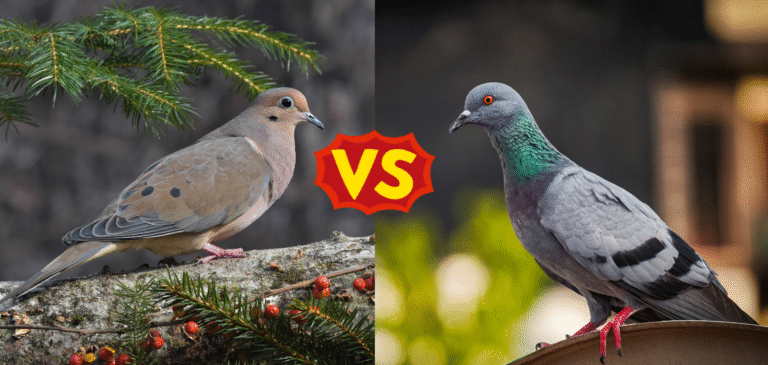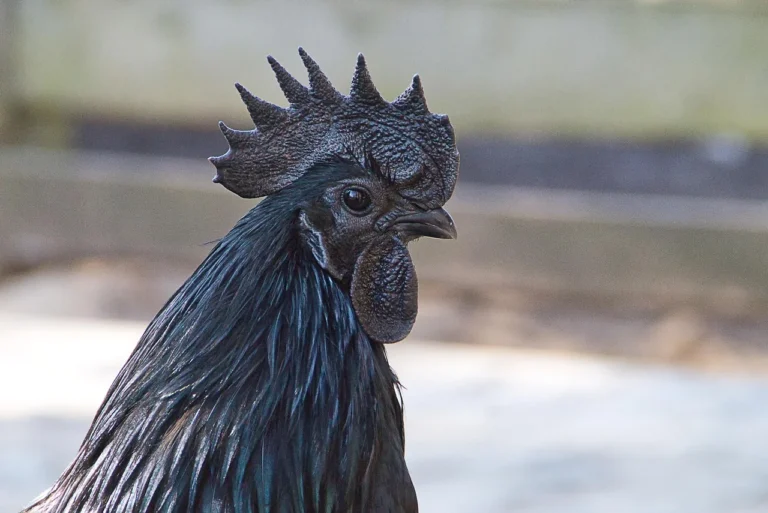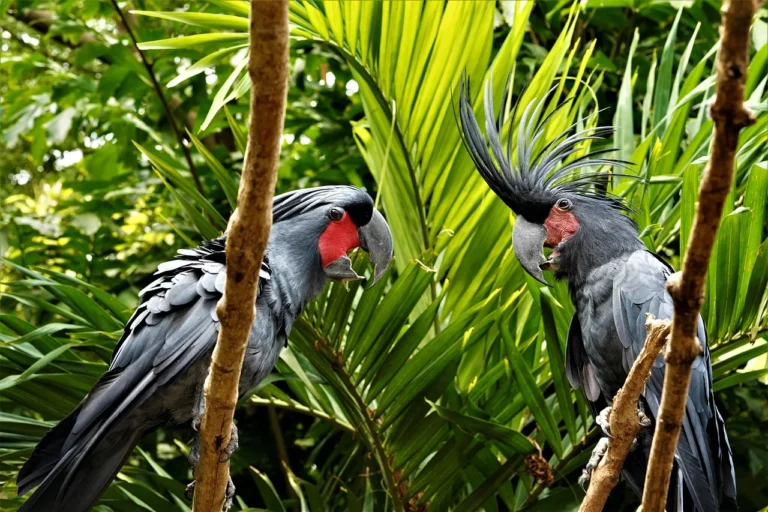Wondering about the difference between dove and pigeon? They’re not the same, but they’re not entirely different either. Doves and pigeons belong to the same bird family, yet people treat them like two separate species.
It’s one of those classic confusions. You see a small, white bird at a wedding and call it a dove. Spot a grey bird walking near a garbage bin and call it a pigeon. But here’s the catch: Both birds come from the same scientific family, Columbidae. The terms “dove” and “pigeon” aren’t tied to strict biological rules. They’ve become labels people toss around based on size, color, or even mood.
This mix-up isn’t new. Language, culture, and even religion have shaped how we view these birds. In some places, every bird that coos gets called a pigeon. In others, only the white, peaceful ones earn the “dove” tag. But if you’re trying to understand the actual differences, then it helps to dig into their size, behavior, where they live, and how they interact with humans.
This is what this guide is all about, explaining the scientifically correct difference between dove and pigeon. So, walk with us to learn more.
Same Family, Different Names
You’ve probably heard people use “dove” and “pigeon” like they’re two different birds from two different worlds. But the truth is, they’re both sitting on the same family tree. What makes things tricky is how people across different countries, languages, and cultures have slapped different labels on them. So, before we get into how they look or behave, let’s clear up the name game:
The Scientific Connection
Let’s start with the basics. Doves and pigeons both belong to the same bird family called Columbidae. There’s no official scientific line that says, “this one’s a pigeon” and “that one’s a dove.” It’s all about how we’ve chosen to name them. In general, people tend to call the bigger, chunkier birds “pigeons” and the smaller, sleeker ones “doves.” But even that’s not a hard rule. It’s more of a pattern than a rulebook. Biologists don’t argue over it too much because the lines aren’t clear-cut.
Etymology and Common Use
Now here’s where things get messier. The word “pigeon” comes from French, while “dove” goes way back to Old English. That alone tells you these words came from different places, not different species. In the UK, people often say “pigeon” for almost all types. In the US, “dove” is the more common word, especially for the ones you’d see in peaceful, poetic scenes. Here’s the table of commonly used names for these birds in different languages:
| Language | Pigeon | Dove |
| Urdu/Hindi | Kabootar | Fakhta |
| French | Pigeon | Colombe |
| Italian | Piccione | Colomba |
| Japanese | Hato | Kijibato |
| Chinese | Gēzi | Bānjiū |
But, wait a second, the story doesn’t end here. Some languages use the same word for both birds. In Dutch, it’s Duif; in Norwegian, Due; in Swedish, Duva; and in Ukrainian, Holub.
There’s also a reason people say “white dove” instead of “white pigeon.” White birds are linked to peace, weddings, and purity. Nobody wants to release a “city pigeon” at a wedding. So even when the bird is technically a type of pigeon, if it’s white and gentle-looking, folks usually call it a dove. It’s all about the image, not the biology.
Physical Differences
If you’ve ever looked at two birds side by side and thought, “That one’s a dove because it’s cuter,” you’re not alone. Most people go by size or color when telling them apart, and while it’s not entirely wrong, it’s not always spot on either. Here’s what you should know in terms of physical differences between dove and pigeon:
Size and Body Shape
As a general rule, doves are the smaller, leaner members of the family. They’ve got a more delicate frame, longer tails, and a sleek build that makes them look a bit more graceful. Pigeons, on the other hand, tend to have rounder bodies, broader chests, and shorter tails. They look like they’ve had an extra helping at dinner.
But don’t get too confident. Some wild doves, like the Laughing Dove or Eurasian Collared Dove, can grow surprisingly big. And some pet pigeons, especially the fancy breeds, stay pretty small. So, while size gives a clue, it’s not the whole story.
Color and Plumage
This is where the stereotypes really kick in. Doves are often seen in soft whites, pale greys, or light browns. That image of a white dove flying out of a cage at a wedding? That’s stuck in everyone’s head for a reason. Pigeons, meanwhile, come in all sorts of shades: Grey, bluish-grey, black, speckled, even with iridescent green or purple on the neck. You’ll see these rock pigeons strutting around cities like they own the place.
And here’s the twist: that pure white “dove” people release at ceremonies is often just a specially bred white pigeon. Looks don’t always match the label, especially when tradition and marketing step in.
Behavior and Habits
When it comes to how birds behave, there’s more going on than just a few coos and wing flaps. Doves and pigeons may share a family tree, but they’ve got different personalities:
Temperament and Nature
Doves usually keep to themselves. They’re soft-spoken, easily startled, and prefer quiet corners. You won’t often find them hanging around loud, crowded areas. They like peace and don’t handle stress too well. Pigeons, on the other hand, are city pros. They strut through busy markets, dodge motorcycles like seasoned traffic cops, and could probably hold their own in a game of street cricket.
Now, when it comes to defending their nests, pigeons actually get pretty bold. They won’t pick a fight just for fun, but if something gets too close to their eggs, they’ll puff up and stand their ground. Doves are more likely to take off and relocate if they feel threatened. So, in the world of bird bravery, pigeons win this round.
Mating and Parenting
Mating in birds varies wildly, some hop from partner to partner, while others pair up for life. Both doves and pigeons are big on commitment. They find a mate and stick with them. It’s almost like they turn down more suitors than pigeons do. Once they’re paired, though, they both share the work, building nests, taking turns warming the eggs, and feeding the chicks.
Their babies are called squabs, and for the first few days, they get something called “crop milk,” which both parents produce. As for nest locations, pigeons are more flexible. They’ll settle on window sills, balconies, rooftops, wherever they find a ledge. Doves are pickier. They’ll choose trees, dense shrubs, or tucked-away spots that feel safer and quieter. It’s the same bird family, but very different real estate choices.
Habitat and Adaptability
One of the easiest ways to tell pigeons and doves apart? Just look at where they’ve made themselves comfortable. Some birds are built for busy streets and human chaos, while others prefer a bit of peace and green:
Where You’ll Find Them
Pigeons are everywhere. Cities, towns, old buildings, train stations, even the inside of abandoned factories. They’ve made themselves at home in the loudest, dirtiest places and somehow still thrive. They’re used to people, cars, horns, and chaos. It’s like they’ve learned to survive on leftover fries and city dust.
Doves? Not so much. They like things a little more peaceful. You’ll usually find them in rural areas, quiet parks, or edges of towns where there’s less foot traffic. They prefer trees, gardens, or quiet rooftops, somewhere they won’t be bothered every five minutes.
Even the way they build their nests shows the difference. Pigeons don’t care too much. A few twigs and random bits on a flat ledge, and they’re done. Doves, while still not master builders, tend to be a bit more careful, often choosing hidden or leafy spots with decent cover.
Diet and Feeding
Both birds go for a plant-based menu: Seeds, grains, fruits, and the occasional green snack. But pigeons aren’t picky. They’re the kind of birds that’ll peck at crumbs, popcorn, or whatever’s on the ground. That’s why they do so well in cities. Scavenging is second nature to them.
Doves are choosier. They stick to cleaner options and prefer feeding in safer, less crowded places. You’re not going to see a dove digging through trash. Also, fun fact: Pigeons can drink water without lifting their heads. They suck it up like a straw. Doves take a sip, then tilt their heads back to swallow.
Cultural and Symbolic Roles
Ask ten people which bird stands for peace, and most will say “dove” without thinking twice. Ask them what they think of pigeons, and you’ll probably hear words like “messy” or “bothersome”. Funny how two birds from the same family ended up with such different reputations:
Religious and Historical Contexts
Doves have long been linked to peace, innocence, and purity. In the Bible, it was a dove that brought Noah the olive branch. In Islamic tradition, pigeons and doves both have respectful standing. Over time, these associations turned doves into sacred symbols, often used in religious art, prayers, and ceremonies.
Pigeons, meanwhile, earned their respect the hard way. They served as messengers during wars, carrying vital information across battlefields. Many even got medals for their service. And when it comes to weddings and rituals, the birds released in white gowns and flower-stuffed cages? Often not doves at all, but white pigeons.
Popular Misconceptions
One of the biggest mix-ups is about those white birds at weddings or memorials. Everyone assumes they’re doves, sent off to symbolize love and peace. In reality, most of them are specially bred white homing pigeons. Real doves wouldn’t even make it back. They’re not built for long flights or loud crowds.
Then there’s the whole “pigeons are dirty, doves are pure” nonsense. Truth is, pigeons aren’t naturally dirty. They just live in messy places. You put any bird in a crowded, polluted area, and it’s going to look rough. Doves seem “cleaner” mostly because people see them in calmer, greener settings.
Human Interaction
Humans have been keeping birds around for ages. Sometimes for company, sometimes for help, and sometimes just because they looked nice in a cage. When it comes to pigeons and doves, both have played a role in our lives, but one’s been more of a worker, while the other’s been treated like a symbol:
As Pets and Domestication
If you’re thinking about keeping one of these birds as a pet, pigeons usually make the better choice. They’re easier to care for, more adaptable, and build stronger bonds with humans. Many people are surprised at how affectionate and calm pigeons can be once they trust you. They’re also smart enough to recognize faces and routines.
Doves are more delicate. They need more space to move around, and they spook easily. While they’re beautiful and gentle, they don’t warm up to humans as quickly as pigeons do. In terms of cage size and maintenance, pigeons need a bit more space, but they’re also better at handling mild changes in their environment.
Role in Science and Messaging
Pigeons aren’t just pets. They’ve been lab assistants too. In psychology, B.F. Skinner used pigeons in his famous box experiments to study behavior, reward, and learning. Those little birds helped shape modern behavioral science, all while pecking at buttons for food. Historically, pigeons also carried messages in warzones and between cities, using their homing ability to deliver critical info. Entire communication systems relied on them before technology took over.
That said, doves have found their own role in wildlife conservation. Researchers use them to study population patterns, habitat changes, and even climate effects in rural areas. They might not deliver mail or do tricks in a lab, but they’re still helping quietly, just like you’d expect from a dove.
Lifespan, Sounds, and Flight
When it comes to pigeons and doves, most folks focus on how they look. But how they sound and move can tell you just as much, sometimes more:
Lifespan
In the wild, doves usually live around 1 to 3 years, mostly because they’re smaller, more vulnerable, and not as street-smart. Predators, weather, and lack of food hit them hard. But if you’re keeping one in a safe, clean environment, they can live up to 10 to 12 years, sometimes even a bit more with proper care.
Pigeons, on the other hand, are tougher. In the wild, they can stick around for 3 to 6 years, depending on how rough the environment is. But in captivity or under human care, they’ve been known to live 15 years or longer, especially the homing and fancy breeds. Some racing pigeons even make it past 20.
Vocalization Differences
Doves tend to keep things soft and gentle. Their coo is more of a background hum. It’s calming, rhythmic, almost like a lullaby on loop. Pigeons, on the other hand, sound like they’ve got something serious to say. Their cooing is deeper, throatier, and a bit louder, especially when they’re trying to impress a mate or claim a spot.
When it comes to noise levels, pigeons are definitely the louder ones. They’ll call out more often and with more force, especially if they’re feeling territorial. Doves will coo too, especially during mating season, but they keep it subtle.
Flight Style and Patterns
Now watch them take off, and the difference is crystal clear. Doves are quicker off the ground. Their flight is sharp, fast, and full of sudden moves. It’s like they’re built for quick escapes and dodging trouble. They flap hard, dart from side to side, and don’t hang around for long.
Pigeons? They play the long game. They’ve got strong wings and stamina to fly across cities or even return home from miles away. Their flight is smoother, more controlled, and powerful. And here’s something people don’t always notice: Pigeons make a noticeable sound with their wings during takeoff.
Final Words
So, doves and pigeons, not as different as people think, but not identical either. Same family, different habits, appearances, and reputations. One thrives in chaos, the other prefers calm. One got medals in wars, the other got invited to weddings. At the end of the day, it’s not about which bird is better, it’s about understanding them beyond the labels we’ve given.
If you’re curious about more bird facts, odd behavior, or just enjoy spotting feathers in the wild, keep visiting our blog.



